

STEM Timeline - Google Slides. STEM Goals - Google Slides.
Log In. Monitoring Progress Toward Successful K-12 STEM Education: A Nation Advancing? Identifying and Supporting Productive STEM Programs in Out-of-School Settings. Educate to Innovate: Factors That Influence Innovation: Based on Input from Innovators and Stakeholders. Overview Authors Arden Bement, Jr.; Debasish (Deba) Dutta; Lalit Patil; National Academy of Engineering; University of Illinois at Urbana-Champaign Description Robust innovation in the United States is key to a strong and competitive industry and workforce.
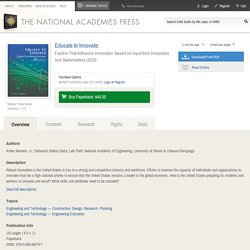
Efforts to improve the capacity of individuals and organizations to innovate must be a high national priority to ensure that the United States remains a leader in the global economy. [read full description] The aim of the Educate to Innovate project is to expand and improve the innovative capacity of individuals and organizations by identifying critical skills, attributes, and best practices - indeed, cultures - for nurturing them. Topics Publication Info 102 pages | 8.5 x 11 Paperback ISBN: 978-0-309-36879-7 Contents Research Suggested Citation National Academy of Engineering. Import this citation to: Reference Finder Find relevant information like your own rough draft from among the thousands of reports available for free at NAP.edu.
Rights. Expanding Underrepresented Minority Participation: America's Science and Technology Talent at the Crossroads. Successful K-12 STEM Education: Identifying Effective Approaches in Science, Technology, Engineering, and Mathematics. Overview Authors.

STEM Integration in K-12 Education: Status, Prospects, and an Agenda for Research. Overview Winner of ITEEA's Council on Technology and Engineering Teacher Education 2015 Outstanding Research Award Authors Margaret Honey, Greg Pearson, and Heidi Schweingruber, Editors; Committee on Integrated STEM Education; National Academy of Engineering; National Research Council Description STEM Integration in K-12 Education examines current efforts to connect the STEM disciplines in K-12 education.
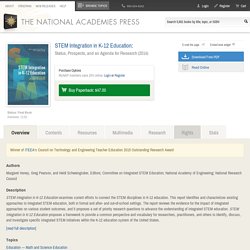
[read full description] Motor car and galimoto: An intercultural lesson in pragmatism, creativity, and perseverance. This interdisciplinary lesson invites elementary students to explore the circumstances of a Kondi, a seven-year-old boy living in Malawi, Africa, through the book Galimoto, by Karen Lynn Williams.
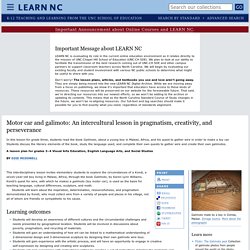
Kondi’s quest for wire, with which he makes a galimoto (toy motor car), is used as the basis for teaching language, cultural differences, sculpture, and math. Students will learn about the inspiration, determination, resourcefulness, and pragmatism demonstrated by Kondi, who must collect wire from a variety of people and places in his village, not all of whom are friendly or sympathetic to his cause. Learning outcomes Students will develop an awareness of different cultures and the circumstantial challenges and needs presented by geographical location. Teacher planning Time required for lesson. STEMGuide. New science and math school fills Silicon Valley demand for better STEM Education - Peninsula Press.
In the heart of San Jose, just off Highway 280, stands a sleek black office building previously owned by IBM.
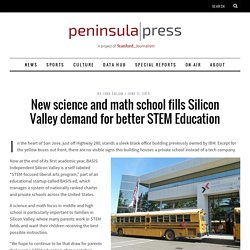
Except for the yellow buses out front, there are no visible signs this building houses a private school instead of a tech company. The exterior of BASIS Silicon Valley — a prior IBM building. (Isha Salian/Peninsula Press) Now at the end of its first academic year, BASIS Independent Silicon Valley is a self-labeled “STEM-focused liberal arts program,” part of an educational startup called BASIS.ed, which manages a system of nationally ranked charter and private schools across the United States. A science and math focus in middle and high school is particularly important to families in Silicon Valley, where many parents work in STEM fields and want their children receiving the best possible instruction. This classroom is home to the technology and engineering elective, as well as the robotics and car clubs. BASIS Charter Schools (BSI Inc.) The following is an example of 5 – 12th grade curriculum for a fully built out BASIS middle / high school.

Please note that curriculum may slightly differ at each BASIS campus. To view BASIS Course Sequence, please click here. Saxon curriculum5th grade begins with 7/6 or 8/7 (Pre-algebra)11th grade may finish with Calculus BCPost-AP or Capstone in 12th grade 5th grade Physical GeographyIntroduction to Science (Biology, Chemistry, Physics) 6th – 8th grade Biology, Chemistry & Physics: all three every year! 9th – 12th grade. 2 Million Minutes: A Global Examination (13 Minute Cut) Part 1. Competency-Based Learning or Personalized Learning. Transitioning away from seat time, in favor of a structure that creates flexibility, allows students to progress as they demonstrate mastery of academic content, regardless of time, place, or pace of learning.
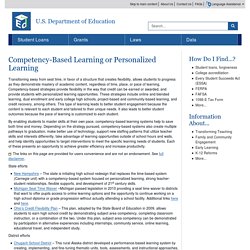
Competency-based strategies provide flexibility in the way that credit can be earned or awarded, and provide students with personalized learning opportunities. These strategies include online and blended learning, dual enrollment and early college high schools, project-based and community-based learning, and credit recovery, among others. This type of learning leads to better student engagement because the content is relevant to each student and tailored to their unique needs. It also leads to better student outcomes because the pace of learning is customized to each student. By enabling students to master skills at their own pace, competency-based learning systems help to save both time and money. State efforts District efforts Alternative/credit recovery schools and programs. STEM article 1. CEW Georgetown.